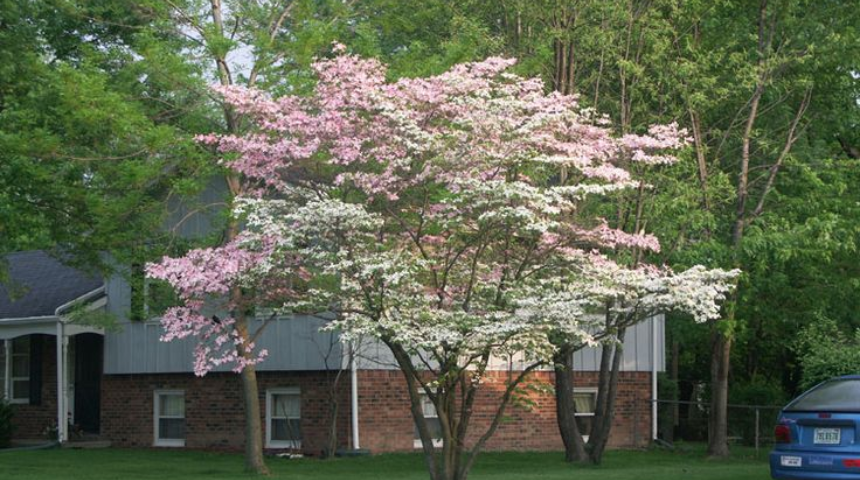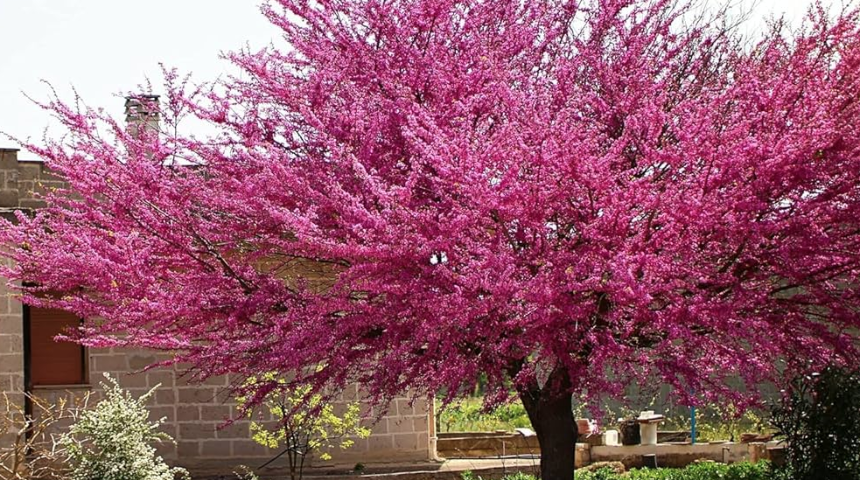As a seasoned gardener, I know what is a good flower tree to plant near a house can transform any yard into a beautiful and inviting space.
The right tree not only adds charm and color but also brings shade and fresh air. But with so many types of flowering trees, deciding which one suits your home best can feel overwhelming.
I’ve experimented with various types, learning which ones thrive in different climates and garden spaces. In this post, I’ll guide you through selecting a perfect flower tree for your landscape, focusing on beauty, size, and maintenance.
Planting a tree close to the house needs careful planning. The ideal choice should be a tree that won’t crowd the house or damage its foundation. I’ll share my top recommendations and practical tips for planting and care.
By the end, you’ll feel confident in picking a flower tree that fits beautifully and lasts for years.
What Is A Good Flower Tree To Plant Near A House?
When elevating a home’s curb appeal, flower trees are a timeless choice. The sight of colorful blossoms greeting you each time you walk up to your front door can make a house feel like a true sanctuary.
But selecting the right flower tree to plant near a house goes beyond just looks—it requires considering factors like size, maintenance, and compatibility with your local climate.
Not only can these trees create an impressive visual impact, but they can also provide shade, attract beneficial wildlife, and improve air quality around your home.

Let’s dive into why flower trees make such a valuable addition and how to choose the perfect one for your yard.
Benefits of Planting Flower Trees Near a House
Enhancing Curb Appeal
A flowering tree can be the showpiece of your yard, capturing the attention of passersby and visitors alike.
Whether in full spring bloom or sporting vibrant fall colors, a well-placed flower tree draws attention to the landscape and adds an elegant, natural element that complements any architectural style.
Providing Shade and Cooling
Planting the right flower tree can also offer practical benefits. During warmer months, a well-placed tree provides natural shade, reducing the need for air conditioning.
Flower trees like the Japanese Maple or Magnolia offer not just beauty but also shade, cooling your home and reducing energy costs.
Creating Natural Habitat
By planting flower trees near your home, you’re inviting a whole new world of nature to your doorstep. Many flowering trees attract birds, butterflies, and pollinators like bees, which play an essential role in the ecosystem. This natural habitat makes your garden come alive and contributes to biodiversity.
Air Purification
Trees help purify the air around them, absorbing pollutants and releasing oxygen. Flowering trees do this just as well, creating cleaner and fresher air, which benefits you and your family.
Planting them near the home lets you enjoy the added bonus of natural air filtration right outside your window.
Factors to Consider Before Planting
Choosing a flower tree involves balancing beauty with practical considerations. Here are some key factors to keep in mind:
Size and Growth Rate
The size and growth rate of the tree are critical. A tree that grows too large can pose a risk to your home’s foundation, plumbing, or roof.
Choosing a tree with manageable growth, like Dogwood or Japanese Maple, ensures it stays proportionate to your yard’s size without causing structural issues.
Climate and Hardiness
Different flower trees thrive in different climates. Make sure the tree you choose is compatible with your USDA hardiness zone to ensure it will flourish.
For example, Redbuds do well in colder climates, while Crape Myrtles thrive in warmer areas. Checking climate suitability helps ensure the tree can handle local conditions year-round.
Soil Requirements
Not all trees grow in all soil types, so it’s important to check soil compatibility. Some trees prefer well-drained, slightly acidic soil, while others are more tolerant.
Testing your soil’s pH can help you select a tree that matches your garden’s natural composition, increasing its chances of healthy growth.
Maintenance Needs
Flower trees vary in terms of upkeep, from low-maintenance options like Crape Myrtles to trees that require frequent pruning.
If time is a factor, look for trees that are known for low maintenance. However, even low-maintenance trees will benefit from regular watering, mulching, and occasional trimming.
Top Flower Trees to Plant Near a House
Here are some of the best flower trees for planting near a house. These options balance aesthetic appeal, manageable growth, and resilience, making them perfect for residential landscaping.
Dogwood (Cornus florida)
Known for its stunning springtime blooms, Dogwood is a popular choice for residential landscapes. It’s a small to medium-sized tree, generally reaching 15-30 feet tall, making it ideal for yards where space is limited.

Dogwoods also offer year-round interest, with attractive red berries in fall and beautiful bark in winter. They’re perfect for colder climates and can tolerate partial shade.
Japanese Maple (Acer palmatum)
Japanese Maples are celebrated for their delicate, feathery foliage and beautiful spring flowers. These small trees grow slowly, often topping out at around 15 feet, making them ideal for smaller spaces.

Japanese Maples add dramatic foliage colors in autumn, ranging from deep reds to vibrant oranges. They’re also relatively low-maintenance and can thrive in partial shade, making them perfect for planting near a house.
Magnolia (Magnolia spp.)
Magnolias are known for their large, fragrant blossoms that add a touch of elegance to any garden. They grow to a moderate height, usually around 20-30 feet, and provide excellent shade.

Magnolia flowers vary in color, from pure white to pink and purple. Since these trees can grow quite wide, consider planting them where they’ll have plenty of room to spread. They’re hardy in various climates but perform best in areas with mild winters.
Redbud (Cercis canadensis)
The Redbud is another wonderful choice for planting near a house. Its distinctive pink or purple blossoms bloom early in spring, providing vibrant color before many other trees have started to leaf out.

Redbuds typically grow to 20-30 feet, making them suitable for small to medium yards. They are hardy and adaptable, thriving in a variety of climates, and their heart-shaped leaves add charm long after the flowers have fallen.
Crape Myrtle (Lagerstroemia)
Crape Myrtles are known for their long-lasting, colorful blooms that appear from summer to fall. They’re a versatile option, available in dwarf varieties as small as 3 feet or larger types that can grow up to 25 feet.

Crape Myrtles have a beautiful, multi-stemmed growth habit, and their peeling bark adds interest even in winter. These trees are drought-tolerant and low-maintenance, thriving in sunny locations with well-drained soil.
Tips for Planting and Caring for Flower Trees Near a House
To maximize the lifespan and health of your flower tree, follow these essential tips for planting and care:
Location Selection
Planting too close to the house can cause problems over time, especially as roots grow. To avoid this, place the tree at least 10-20 feet from the foundation. This distance provides room for growth without the risk of root interference.
Watering and Feeding
Newly planted trees require regular watering until they establish their roots. Check the soil’s moisture level to avoid overwatering, and apply a balanced, slow-release fertilizer in early spring to promote healthy growth.
Pruning
Prune your flower tree annually to maintain its shape and size, especially if it’s near the house. Removing dead or diseased branches also encourages better airflow, which reduces the risk of pests and diseases.
Pest and Disease Prevention
Keep an eye out for pests such as aphids, scale insects, or borers, which can damage the tree. Applying a mild, organic pesticide or horticultural oil can help control pests if needed.
Regularly inspect your tree for signs of disease, such as discolored leaves or unusual growths, and address issues promptly.
FAQ
What are the best low-maintenance flower trees?
For minimal maintenance, consider Crape Myrtle or Japanese Maple. Both are hardy and require little upkeep once established.
How close can I plant a tree to my house?
Generally, planting trees at least 10-20 feet from the foundation is best. This distance allows the tree to grow without risking structural damage.
What flower trees are safe for small yards?
Japanese Maple and Redbud are excellent for small spaces, as they remain relatively compact. Dwarf varieties of Crape Myrtle are also suitable for limited areas.
Do flower trees attract bees and birds?
Yes, many flowering trees, including Dogwood and Redbud, attract birds, butterflies, and bees, which benefit the ecosystem.
Which trees offer the longest blooming season?
Crape Myrtle has one of the longest blooming seasons, with flowers that last from mid-summer through fall.
Conclusion
Choosing the right flower tree to plant near a house can be a transformative addition to any landscape. Not only do these trees provide vibrant colors and lush foliage, but they also bring practical benefits like shade, wildlife support, and air purification.
When selecting a flower tree, consider factors like size, climate compatibility, and maintenance needs to ensure it fits seamlessly into your outdoor space.
Whether you choose a stunning Magnolia, a vibrant Crape Myrtle, or a delicate Japanese Maple, the right flower tree can turn an ordinary yard into a beautiful retreat.
Ready to transform your garden? Explore flower tree options suited to your climate, and bring lasting beauty to your home.



